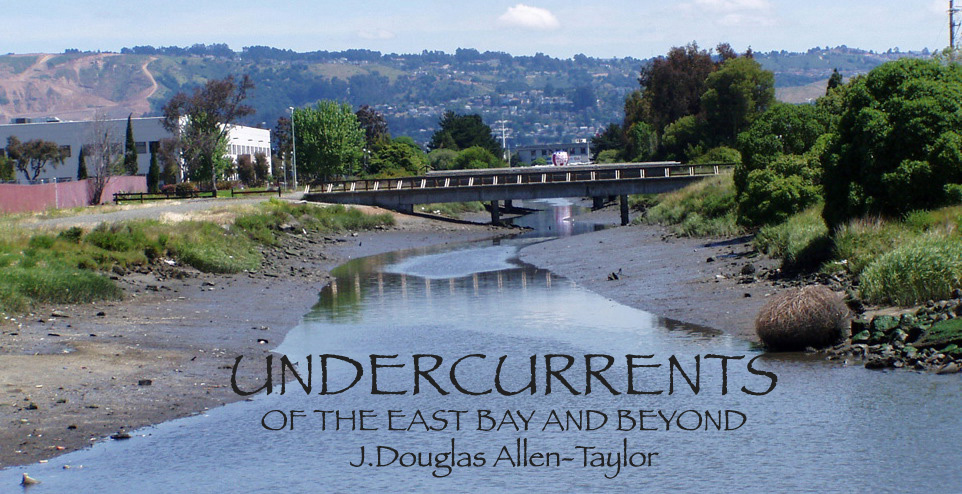

SOME THOUGHTS ON THE STEPCHILD ISSUE
 Transportation—the stepchild of public
issues—has suddenly resurfaced as a concern in certain Oakland political circles.
Transportation—the stepchild of public
issues—has suddenly resurfaced as a concern in certain Oakland political circles.
I know, I know. It’s not a glamorous issue, like crime or the schools or downtown
development. It’s simply the issue that ties all of the rest of the issues together,
and so deserves more attention than we’re giving it.
On Tuesday, county supervisors passed a resolution—introduced by Board of Supervisors
President Keith Carson—“supporting equitable financial support of AC Transit by the
Metropolitan Transportation Commission for the benefit of its passengers.”
If you walked down the aisle of one of the buses running the 82 line along International
and handed that out in a leaflet and asked any of the passengers what it meant, you
most certainly would get back mostly blank stares, at best. What it meant, if you
had the time to take off work and attend Tuesday morning’s meeting, or if you read
about it in Wednesday’s Tribune, was that supervisors voted 3-1 to chastise
the regional transportation commission for putting the lion’s share of its money
into BART, while letting AC Transit slowly waste away, even though AC Transit is
a transportation lifeline to many county residents.
On the same day as the supervisors meeting, Grand Lake area community activist Caroline
Kim raised a similar point in her “Neighborhood News” email newsletter. “The Monday,
April 17 Oakland Tribune had a glowing article about the BART monorail connector,”
Ms. Kim wrote. “Of course, the article had no detailed financial analysis. The project
is now expected to cost over $400 million. … The fares from the Coliseum BART Station
to the airport are estimated to range from $3.75 to $5.50 per trip. (It's now $2
on their connector bus.) This cost would be in addition to the fare to the Coliseum
Station. They think they will get 13,500 riders a day but they're not considering
a main problem: BART does not serve most of the neighborhoods in Oakland.”
Ms. Kim goes on to note that “the City of Oakland is one of the agencies pushing
the development. This month, the council will vote on whether to give BART a $725,000
in-kind contribution for the project.” She concludes by saying “think what $400 million
would mean for bus transit for this city—fast service for all the neighborhoods rather
than expensive service for those near a BART line.”
If and when it is finished, the BART monorail connector Ms. Kim referred to will
provide rail transportation from the Coliseum BART Station to the Oakland International
Airport, a trip you can now take on a special connector bus.
Driving Oakland’s streets and highways, or riding on the two major public transit
systems available here—AC Transit and BART—it is hard to see how the airport
monorail rates $400 million in overall funds ($725,000 coming out of the Oakland
budget) over other transportation needs.
Consider this little bit of lunacy.
I live near International Boulevard just south of 73rd Avenue. Once a few months
ago, when my car was out of commission, I had to take the bus to attend to some business
on a location on MacArthur between 35th Avenue and Fruitvale. To do so, I had to
take an International bus to 35th, transfer to a crosstown route, and then transfer
again to a MacArthur Avenue bus to get to my destination. It’s all one trip, all
in the same direction, and logic would seem to indicate that it would cost one adult
fare: $1.75. That’s steep enough in itself, but it isn’t all. AC Transit charges
an extra 25 cents to get a transfer. Not a lot, but, then, you don’t get a lot for
it, because the transfer is only good for one use. This may have some logic if the
rider wants to return the way they came, but not so much when you’re continuing along
on the same trip. When I got to 35th and MacArthur, I either had to pay a second
full fare to continue on the same trip, with the same bus service, or walk. Figuring
that $3.75 was more than one should have to pay to catch a bus within the city, I
chose to walk.
Is there any wonder why people abandon AC Transit as soon as they can?
In voting against Supervisor Carson’s resolution calling for more MTC money for AC
Transit this week, the Tribune quoted Supervisor Scott Haggerty as telling
fellow supervisors to “take the argument to the AC Board. Take this to them and ask
them why they're cutting the routes in the flatlands. Ask them why they're cutting
service on the flatland."
It is tempting, of course, to blame AC Transit for the AC Transit problems, and many
have done so. But AC Transit is charged with balancing its budget, and when that
budget is not balanced, it must either make service cuts or introduce fare hikes.
In either case, that makes the system less popular, leading to more people abandoning
the buses, leading to less money coming into the system, and so to more service cuts
and fare hikes—a sort of downward death spiral that will eventually lead to a skeleton
public bus service in the East Bay if it is not halted.
One answer might be to make the Metropolitan Transportation Commission an actual
transit system, running all of the public transportation within its jurisdiction
rather than doling out money to competing systems. In that way, someone could be
looking at overall public transit needs in the East Bay, instead of refereeing fights
over funds.
A Metropolitan Transportation Commission running both BART and AC Transit might come
to the conclusion that in some parts of Oakland, neither system fully serves the
public, and some sort of in-between transit line is needed. On International Boulevard
between the lake and the San Leandro border, for example, that might mean putting
in a light rail line, similar to what is operating so successfully in San Jose. It’s
cheaper to build than BART, and has the added bonus that it would serve more people
traveling within Oakland, rather than simply passing through to their jobs or a baseball
game.
To accomplish that goal, however, East Bay citizens would have to stop seeing public
transit expenses as a “subsidy”—something our conservative friends have successfully
turned into a bad word—and see it once again as a public service. More than that,
a public necessity, as much as police and fire.
The discussion on transportation ought to be going hand-in-hand with the public debate
over Oakland’s commercial future.
We’ve said it before in this column: Mayor Jerry Brown and his supporters on City
Council have focused in recent years on rebuilding Oakland’s downtown commercial
core. Mr. Brown’s plan was to move 10,000 new residents into the downtown area, in
hopes that the department stores would follow. But even if that ever ends up working—and
so far, there is no evidence that it will—it would still leave the downtown area
as difficult to reach for non-downtown residents as before. 880 seems to be on semi-permanent
lockdown mode most days, weekends included, and except for Sundays, the downtown
area is not a parking-friendly environment. So even if J.C. Penneys and Nordstrom’s
eventually flock to Mr. Brown’s new downtown, a circumstance that would jam the area’s
streets and parking lots even more, how does it benefit most of Oakland’s shoppers?
The same is true for Oakland’s various already-successful neighborhood commercial
districts—Lakeshore/Grand, the Fruitvale, College Avenue, the Laurel District, Chinatown,
and so forth. These districts could expand—attracting more customers from both Oakland
and beyond—but the lack of parking and/or adequate public transportation, along with
Oakland’s strangled transportation arteries, blocks them from doing so.
In such a circumstance, why are we spending $400 million—some $725,000 of it projected
to be from Oakland—on a monorail between the Coliseum BART Station and the Oakland
International Airport instead of putting more money to use on solving more pressing
transportation problems?
This is an area in which leadership and community vision are sorely needed and, so
far, have been sorely lacking. Another job left undone by the current mayor, to be
put on the desk of whoever takes his place.